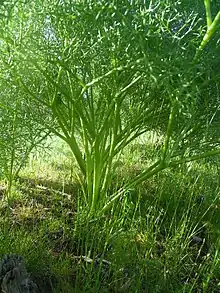Prangos ferulacea
Prangos ferulacea, known in Italy as common basilisk (basilisco comune) is a perennial herbaceous plant present in the Mediterranean Basin, Bulgarian Black Sea Coast, and the Caucasus.
| Prangos ferulacea | |
|---|---|
 | |
| Scientific classification | |
| Kingdom: | Plantae |
| Clade: | Tracheophytes |
| Clade: | Angiosperms |
| Clade: | Eudicots |
| Clade: | Asterids |
| Order: | Apiales |
| Family: | Apiaceae |
| Genus: | Prangos |
| Species: | P. ferulacea |
| Binomial name | |
| Prangos ferulacea (L.) Lindl. | |
| Synonyms | |
| |
Description
Herbaceous plant 60–150 cm tall, stem has a diameter of 1-2 cm at the base. Its leaves are glabrous and light green, broadly ovate to ovate-triangular or oblong-elliptic and repeatedly pinnate. Its basal leaves have up to 50-80 cm long petioles, at the base they are divided into 3 lobes, each 4-5 times pinnate. Its terminal lobes are linear, lanceolate or almost filiform, with 1 vein, at the apex they are shortly pointed. The lower stem leaves are shorter-stalked and the uppermost are sessile, much smaller and less dissected, with sheaths enclosing the stem. The complex umbels are about 15 cm in diameter, with 6-18 main rays, at the base with a sheath of linear-lanceolate and membranous leaves. Awns are about 1 cm wide. Its petals are about 1 mm long, obovate or elliptic. The fruits are 10-25 mm long, about 10 mm wide, ovoid to elliptical, slightly laterally flattened. Blooms in May-June and bears fruit in June - August. It is pollinated by insects and propagated by seeds.[1]
Distribution
The species is distributed in Italy and the island of Sicily, Romania, Bulgaria, the Caucasus, Turkey, Armenia and Iran. In Bulgaria, it is found along the Black Sea coast - Medni Rid and Maslen nos, as well as on Bakadzhitsite, up to about 300 m above sea level.[1] It is an endangered species in Bulgaria, included in the Red Book of the Republic of Bulgaria and in the Bulgarian Law on Biological Diversity.[1] In northern Sicily it grows on limestone in association with endangered fungus Pleurotus nebrodensis.[2]
References
- Чавдар Гусев. "Ферулов прангос :: Червена Книга на Република България". Червена книга на България (in Bulgarian). Retrieved 2023-02-21.
- Venturella, G. (2016). "Pleurotus nebrodensis ssp. nebrodensis". IUCN Red List of Threatened Species. 2016: e.T61597A102952148. doi:10.2305/IUCN.UK.2016-3.RLTS.T61597A102952148.en. Retrieved 18 November 2021.